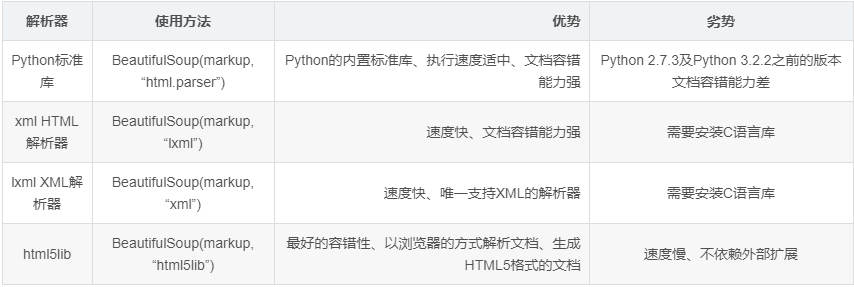这篇文章主要讲解了python中如何使用Beautiful Soup,内容清晰明了,相信大家阅读完之后会有帮助。
Beautiful Soup就是Python的一个HTML或XML的解析库,可以用它来方便地从网页中提取数据。它有如下三个特点:
首先,我们要安装它:pip install bs4,然后安装 pip install beautifulsoup4.
Beautiful Soup支持的解析器

下面我们以lxml解析器为例:
from bs4 import BeautifulSoup
soup = BeautifulSoup('<p>Hello</p>', 'lxml')
print(soup.p.string)
结果:
Hello
beautiful soup美化的效果实例:
html = """
<html><head><title>The Dormouse's story</title></head>
<body>
<p class="title" name="dromouse"><b>The Dormouse's story</b></p>
<p class="story">Once upon a time there were three little sisters; and their names were
<a href="http://example.com/elsie" rel="external nofollow" rel="external nofollow" rel="external nofollow" class="sister" id="link1"><!-- Elsie --></a>,
<a href="http://example.com/lacie" rel="external nofollow" rel="external nofollow" rel="external nofollow" class="sister" id="link2">Lacie</a> and
<a href="http://example.com/tillie" rel="external nofollow" rel="external nofollow" rel="external nofollow" class="sister" id="link3">Tillie</a>;
and they lived at the bottom of a well.</p>
<p class="story">...</p>
"""
from bs4 import BeautifulSoup
soup = BeautifulSoup(html, 'lxml')#调用prettify()方法。这个方法可以把要解析的字符串以标准的缩进格式输出
print(soup.prettify())
print(soup.title.string)结果:
<html>
<head>
<title>
The Dormouse's story
</title>
</head>
<body>
<p class="title" name="dromouse">
<b>
The Dormouse's story
</b>
</p>
<p class="story">
Once upon a time there were three little sisters; and their names were
<a class="sister" href="http://example.com/elsie" rel="external nofollow" rel="external nofollow" rel="external nofollow" id="link1">
<!-- Elsie -->
</a>
,
<a class="sister" href="http://example.com/lacie" rel="external nofollow" rel="external nofollow" rel="external nofollow" id="link2">
Lacie
</a>
and
<a class="sister" href="http://example.com/tillie" rel="external nofollow" rel="external nofollow" rel="external nofollow" id="link3">
Tillie
</a>
;
and they lived at the bottom of a well.
</p>
<p class="story">
...
</p>
</body>
</html>
The Dormouse's story下面举例说明选择元素、属性、名称的方法
html = """
<html><head><title>The Dormouse's story</title></head>
<body>
<p class="title" name="dromouse"><b>The Dormouse's story</b></p>
<p class="story">Once upon a time there were three little sisters; and their names were
<a href="http://example.com/elsie" rel="external nofollow" rel="external nofollow" rel="external nofollow" class="sister" id="link1"><!-- Elsie --></a>,
<a href="http://example.com/lacie" rel="external nofollow" rel="external nofollow" rel="external nofollow" class="sister" id="link2">Lacie</a> and
<a href="http://example.com/tillie" rel="external nofollow" rel="external nofollow" rel="external nofollow" class="sister" id="link3">Tillie</a>;
and they lived at the bottom of a well.</p>
<p class="story">...</p>
"""
from bs4 import BeautifulSoup
soup = BeautifulSoup(html, 'lxml')
print('输出结果为title节点加里面的文字内容:\n',soup.title)
print('输出它的类型:\n',type(soup.title))
print('输出节点的文本内容:\n',soup.title.string)
print('结果是节点加其内部的所有内容:\n',soup.head)
print('结果是第一个p节点的内容:\n',soup.p)
print('利用name属性获取节点的名称:\n',soup.title.name)
#这里需要注意的是,有的返回结果是字符串,有的返回结果是字符串组成的列表。
# 比如,name属性的值是唯一的,返回的结果就是单个字符串。
# 而对于class,一个节点元素可能有多个class,所以返回的是列表。
print('每个节点可能有多个属性,比如id和class等:\n',soup.p.attrs)
print('选择这个节点元素后,可以调用attrs获取所有属性:\n',soup.p.attrs['name'])
print('获取p标签的name属性值:\n',soup.p['name'])
print('获取p标签的class属性值:\n',soup.p['class'])
print('获取第一个p节点的文本:\n',soup.p.string)结果:
输出结果为title节点加里面的文字内容:
<title>The Dormouse's story</title>
输出它的类型:
<class 'bs4.element.Tag'>
输出节点的文本内容:
The Dormouse's story
结果是节点加其内部的所有内容:
<head><title>The Dormouse's story</title></head>
结果是第一个p节点的内容:
<p class="title" name="dromouse"><b>The Dormouse's story</b></p>
利用name属性获取节点的名称:
title
每个节点可能有多个属性,比如id和class等:
{'class': ['title'], 'name': 'dromouse'}
选择这个节点元素后,可以调用attrs获取所有属性:
dromouse
获取p标签的name属性值:
dromouse
获取p标签的class属性值:
['title']
获取第一个p节点的文本:
The Dormouse's story在上面的例子中,我们知道每一个返回结果都是bs4.element.Tag类型,它同样可以继续调用节点进行下一步的选择。
html = """
<html><head><title>The Dormouse's story</title></head>
<body>
"""
from bs4 import BeautifulSoup
soup = BeautifulSoup(html, 'lxml')
print('获取了head节点元素,继续调用head来选取其内部的head节点元素:\n',soup.head.title)
print('继续调用输出类型:\n',type(soup.head.title))
print('继续调用输出内容:\n',soup.head.title.string)结果:
获取了head节点元素,继续调用head来选取其内部的head节点元素:
<title>The Dormouse's story</title>
继续调用输出类型:
<class 'bs4.element.Tag'>
继续调用输出内容:
The Dormouse's story(1)find_all()
find_all,顾名思义,就是查询所有符合条件的元素。给它传入一些属性或文本,就可以得到符合条件的元素,它的功能十分强大。
find_all(name , attrs , recursive , text , **kwargs)
他的用法:
html='''
<div class="panel">
<div class="panel-heading">
<h5>Hello</h5>
</div>
<div class="panel-body">
<ul class="list" id="list-1">
<li class="element">Foo</li>
<li class="element">Bar</li>
<li class="element">Jay</li>
</ul>
<ul class="list list-small" id="list-2">
<li class="element">Foo</li>
<li class="element">Bar</li>
</ul>
</div>
</div>
'''
from bs4 import BeautifulSoup
soup = BeautifulSoup(html, 'lxml')
print('查询所有ul节点,返回结果是列表类型,长度为2:\n',soup.find_all(name='ul'))
print('每个元素依然都是bs4.element.Tag类型:\n',type(soup.find_all(name='ul')[0]))
#将以上步骤换一种方式,遍历出来
for ul in soup.find_all(name='ul'):
print('输出每个u1:',ul.find_all(name='li'))
#遍历两层
for ul in soup.find_all(name='ul'):
print('输出每个u1:',ul.find_all(name='li'))
for li in ul.find_all(name='li'):
print('输出每个元素:',li.string)结果:
查询所有ul节点,返回结果是列表类型,长度为2:
[<ul class="list" id="list-1">
<li class="element">Foo</li>
<li class="element">Bar</li>
<li class="element">Jay</li>
</ul>, <ul class="list list-small" id="list-2">
<li class="element">Foo</li>
<li class="element">Bar</li>
</ul>]
每个元素依然都是bs4.element.Tag类型:
<class 'bs4.element.Tag'>
输出每个u1: [<li class="element">Foo</li>, <li class="element">Bar</li>, <li class="element">Jay</li>]
输出每个u1: [<li class="element">Foo</li>, <li class="element">Bar</li>]
输出每个u1: [<li class="element">Foo</li>, <li class="element">Bar</li>, <li class="element">Jay</li>]
输出每个元素: Foo
输出每个元素: Bar
输出每个元素: Jay
输出每个u1: [<li class="element">Foo</li>, <li class="element">Bar</li>]
输出每个元素: Foo
输出每个元素: Bar看完上述内容,有没有对python中如何使用Beautiful Soup有进一步的了解,如果还想学习更多内容,欢迎关注亿速云行业资讯频道。
亿速云「云服务器」,即开即用、新一代英特尔至强铂金CPU、三副本存储NVMe SSD云盘,价格低至29元/月。点击查看>>
免责声明:本站发布的内容(图片、视频和文字)以原创、转载和分享为主,文章观点不代表本网站立场,如果涉及侵权请联系站长邮箱:is@yisu.com进行举报,并提供相关证据,一经查实,将立刻删除涉嫌侵权内容。